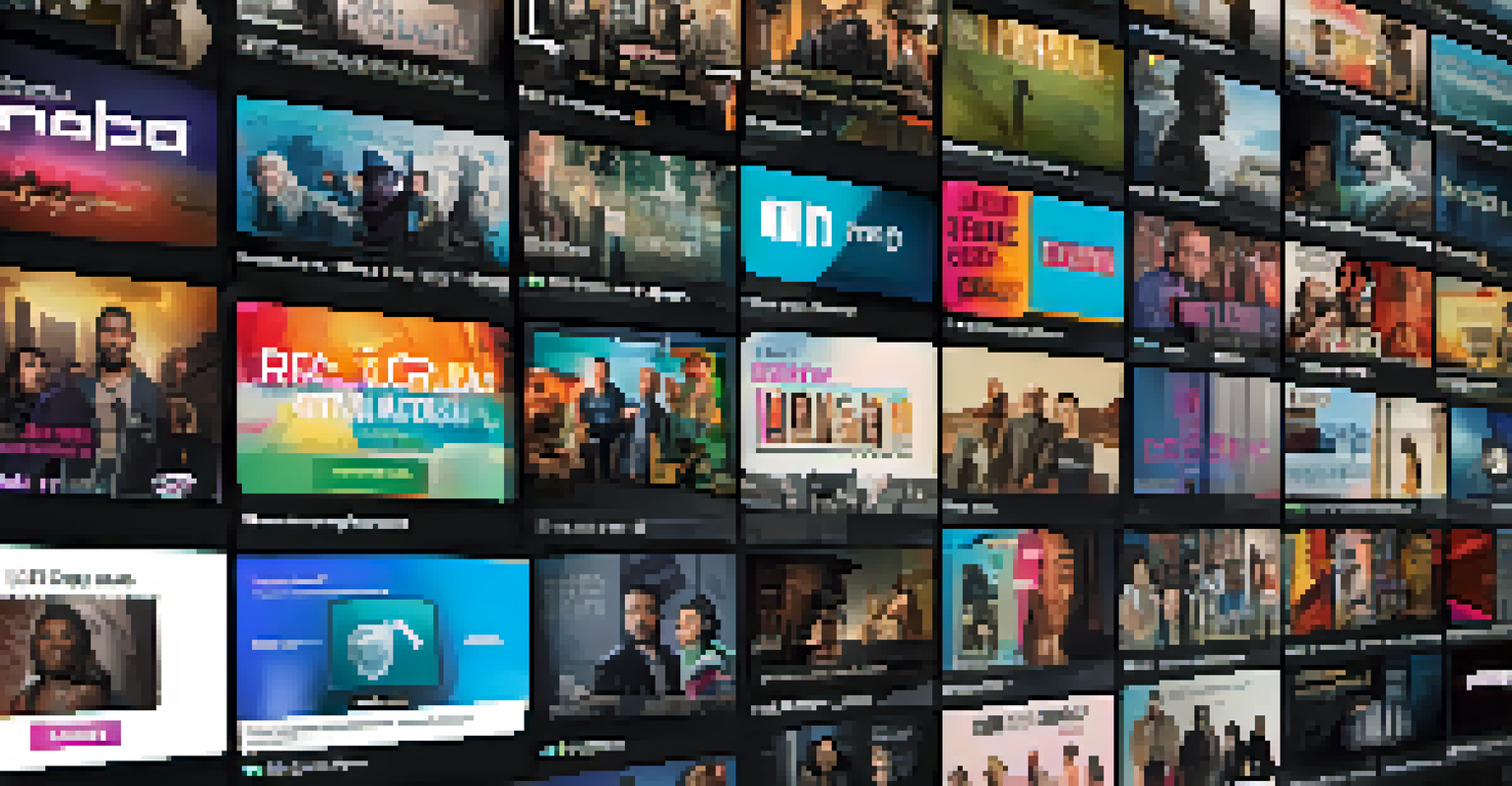The Intersection of Documentaries and Mainstream Cinema

Understanding the Basics: Documentaries vs. Mainstream Films
At first glance, documentaries and mainstream cinema seem worlds apart. Documentaries are grounded in real-life events, often aiming to inform or provoke thought, while mainstream films usually prioritize storytelling and entertainment. However, both forms share a common goal: to connect with audiences and evoke emotions. By understanding their core differences, we can appreciate how they sometimes overlap.
Documentaries are the most powerful weapon in the hands of the public.
Documentaries often use real footage, interviews, and expert commentary to present facts and narratives. In contrast, mainstream films typically rely on scripted dialogue, actors, and fictional plots. This distinction is crucial because it shapes how each genre approaches storytelling. Yet, the lines between them can blur, especially when documentaries adopt cinematic techniques to enhance engagement.
For example, documentaries like 'March of the Penguins' have incorporated narrative elements and stunning visuals to appeal to a broader audience. Meanwhile, films based on true stories, like 'The Social Network,' draw heavily from real events, blurring the lines even further. As we explore this intersection, it's clear that both genres can learn from and enrich each other.
The Rise of Docudramas: Where Fact Meets Fiction
Docudramas represent a fascinating genre that blends documentary-style storytelling with dramatic reenactments. This format allows filmmakers to dramatize real events while still emphasizing authenticity. By using actors to recreate significant moments, docudramas can engage viewers on an emotional level while staying true to factual content.

A prime example of this genre is 'The Crown,' which portrays the life of Queen Elizabeth II. While it takes creative liberties, the series is rooted in historical facts and events. This blend helps audiences connect with history in a more personal way, making the past feel relevant and engaging.
Documentaries Inspire Mainstream Films
Documentaries can spark change and influence mainstream cinema by addressing real-world issues and themes.
Docudramas can sometimes spark debate regarding accuracy and artistic license. Critics argue that by dramatizing events, filmmakers may inadvertently distort facts. However, when done thoughtfully, this genre can serve as a compelling bridge between entertainment and education, allowing viewers to learn while being entertained.
Influential Documentaries That Shaped Cinema Trends
Certain documentaries have not only informed the public but have also influenced mainstream cinema significantly. Films like 'Super Size Me' and 'Blackfish' raised awareness about critical issues, leading to changes in consumer behavior and industry practices. This kind of impact shows that documentaries can extend beyond their own genre to inspire filmmakers and audiences alike.
Cinema is a matter of what’s in the frame and what’s out.
For example, 'Super Size Me' sparked conversations about fast food and health, leading to shifts in how the industry operates. As audiences became more aware, filmmakers began to explore similar themes in fictional narratives, reflecting societal concerns and trends. This demonstrates how documentaries can serve as catalysts for change in mainstream storytelling.
Moreover, the success of impactful documentaries encourages filmmakers in the mainstream realm to take on more socially relevant topics. By integrating real-world issues into their narratives, these films can resonate with viewers, making them more than just entertainment but also a platform for awareness and discussion.
Cinematic Techniques Borrowed from Documentaries
Many mainstream films have adopted techniques traditionally associated with documentaries to enhance their storytelling. For instance, handheld camera work, natural lighting, and real-life settings can create a sense of authenticity. This approach immerses viewers in the story, making them feel like part of the action rather than mere spectators.
Films like 'The Blair Witch Project' and 'Cloverfield' utilize a documentary-style aesthetic to instill a sense of realism and urgency. By presenting the story as if it were unfolding in real-time, these films can evoke genuine fear and suspense, drawing audiences deeper into the narrative. This technique blurs the line between fiction and reality, creating a unique viewing experience.
Docudramas Blend Truth and Drama
Docudramas combine factual storytelling with dramatization, allowing audiences to connect emotionally while learning about history.
Additionally, the use of interviews or direct address in mainstream films can echo documentary styles, allowing characters to break the fourth wall. This technique not only engages viewers but also provides insights into characters' motivations and emotions, making the story more relatable. Such innovations show how the influence of documentaries can enhance the craft of filmmaking across genres.
Mainstream Films Tackling Real Issues: A Growing Trend
In recent years, there has been a noticeable shift in mainstream cinema towards tackling real-world issues. Films addressing topics like mental health, climate change, and social justice have gained traction, reflecting a growing awareness among filmmakers and audiences. This trend underscores the significant influence of documentaries in shaping narratives that resonate with contemporary issues.
Movies such as 'The Pursuit of Happyness' and '12 Years a Slave' have brought important social issues to the forefront, prompting discussions and reflections among viewers. By weaving these themes into their narratives, filmmakers not only entertain but also educate, fostering a more informed audience. The blending of documentary elements into these stories further enhances their impact.
This evolution signifies a broader cultural shift where audiences are increasingly seeking films that reflect their own experiences and concerns. As the lines between documentaries and mainstream cinema continue to blur, we can expect to see even more films that challenge traditional storytelling and provoke thought on pressing global issues.
The Role of Streaming Services in Blending Genres
The rise of streaming services has revolutionized how we consume content, leading to an increase in both documentaries and films that blend genres. Platforms like Netflix and Hulu have made it easier for viewers to access a diverse range of content, including documentaries that may not have reached mainstream audiences otherwise. This accessibility encourages experimentation and innovation across genres.
For instance, Netflix's documentary series 'Tiger King' gained immense popularity, showcasing how a unique narrative can captivate a wide audience. Its success has inspired filmmakers to explore unconventional storytelling methods, incorporating elements of documentary filmmaking into their works. This shift fosters a richer viewing experience, allowing audiences to engage with complex narratives.
Streaming Services Drive Genre Innovation
The rise of streaming platforms encourages filmmakers to experiment with blending genres, leading to unique narratives that capture diverse audiences.
Streaming services also provide filmmakers with the freedom to explore subjects that may not fit traditional cinematic molds. This flexibility encourages the creation of hybrid films that blend documentary and fictional elements, appealing to viewers who crave authenticity alongside entertainment. As the landscape continues to evolve, we can expect even more exciting intersections between these genres.
The Future: What Lies Ahead for Documentaries and Cinema
As we look to the future, the relationship between documentaries and mainstream cinema is likely to become even more intertwined. With audiences increasingly seeking authenticity and meaningful content, filmmakers will continue to draw inspiration from real-life stories. This trend suggests a promising future where documentaries play a crucial role in shaping cinematic narratives.
Moreover, advancements in technology will enable filmmakers to experiment with new storytelling techniques, further blurring the lines between genres. Virtual reality and interactive documentaries are on the rise, offering immersive experiences that traditional cinema may struggle to replicate. Such innovations could transform how we perceive and engage with both documentaries and films.

Ultimately, the intersection of documentaries and mainstream cinema presents endless possibilities for storytelling. As filmmakers embrace this blend, we can expect to see more compelling narratives that resonate with audiences, provoke thought, and inspire change. The journey ahead holds the potential for a richer, more dynamic cinematic landscape.